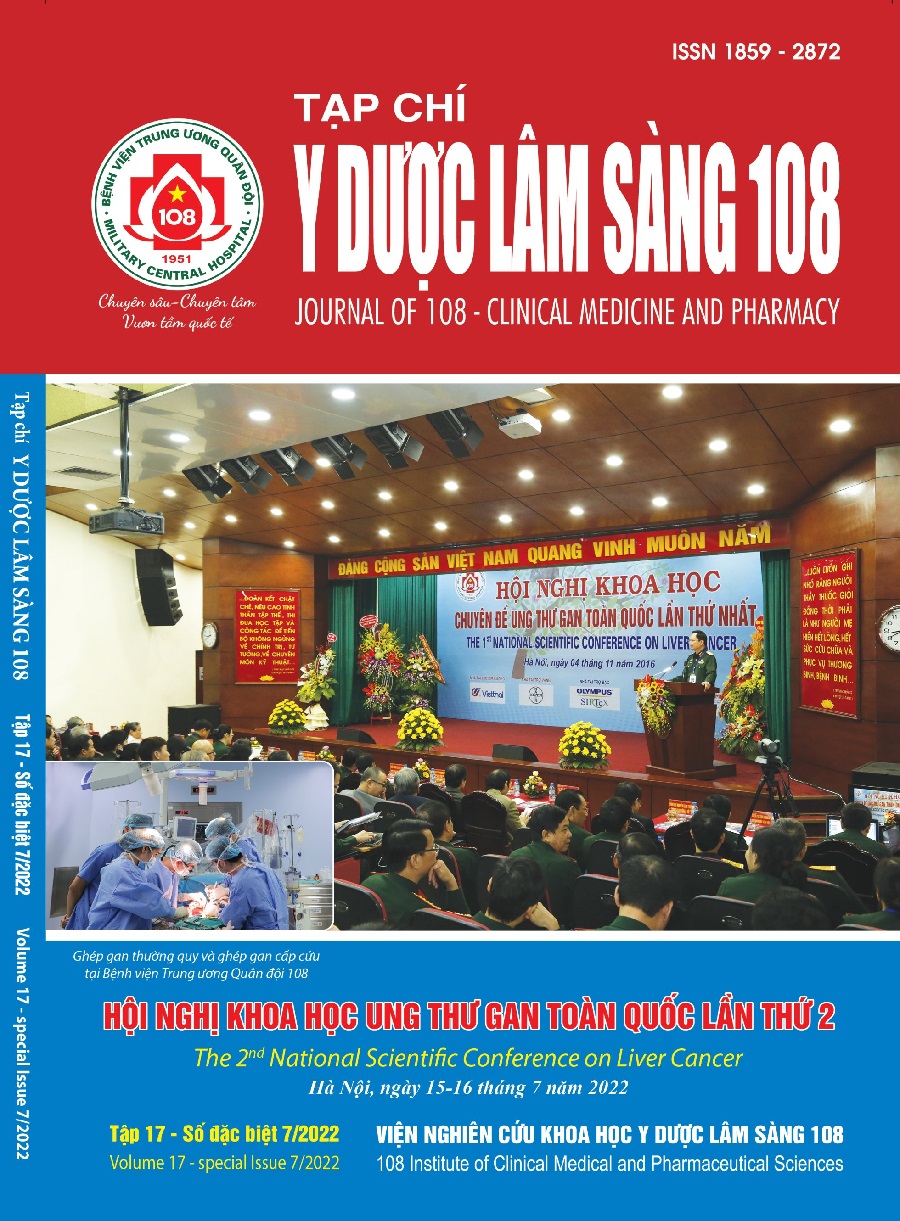Assessment of the toxicities of sorafenib in patients with hepatocelular carcinoma
Main Article Content
Keywords
Abstract
Objective: To assess the toxicities of sorafenib and the effect of adverse events on treatment outcomes. Subject and method: A retrospective and descriptive study on 110 HCC patients treated with sorafenib in K Hospital and Hanoi Medical University Hospital from January 2010 to December 2018. Result and conclusion: The rate of toxicity was 78.2%, majority of which were grade 1 and 2, grade 3 (< 10%), no grade 4. Common toxicities included hand-foot skin reaction (HFSR) (36.4%), fatigue (25.5%) and elevated liver enzymes (32.7%). Toxicities delayed treatment in 22.7% patients, led to dose decrease in 26.4%, and there was no case of treatment cessation due to toxicities. The median onset of AEs was 15 - 30 days, lasted for 1 - 3 cycles of treatment. There was a positive correlation between starting dose and HFSR or hypertension. The positive factors effecting median OS were HFSR (14.6 months vs 5.8 months, p=0.002), stomatitis (23.8 months vs 6.7 month, p=0.045), hypertension (45.2 months vs 6.7 months, p=0.011), no elevated liver enzymes (10.4 months vs 5.9 month, p=0.028). Independent prognostic toxicities to OS were elevated liver enzymes (HR = 2.009, 95% CI: 1.170 - 3.449) and hypertension (HR = 0.154, 95% CI: 0.031 - 0.755).
Article Details
References
2. Llovet JM, Ricci S, Mazzaferro V et al (2008) Sorafenib in advanced hepatocellular carcinoma. New England Journal of Medicine 359(4): 378-390.
3. Kudo M, Finn RS, Qin S et al (2018) Lenvatinib versus sorafenib in first-line treatment of patients with unresectable hepatocellular carcinoma: A randomised phase 3 non-inferiority trial. Lancet 391: 1163-1673.
4. Nguyễn Tuyết Mai (2012) Bước đầu đánh giá hiệu quả Sorafenib (Nexavar) trong điều trị ung thư gan nguyên phát giai đoạn muộn. Tạp chí Y học Việt Nam, 1, tr. 34-37.
5. Vũ Thanh Tú (2013) Nhận xét đặc điểm lâm sàng, cận lâm sàng và kết quả điều trị ung thư gan giai đoạn muộn bằng sorafenib. Luận văn thạc sĩ Y học, Trường Đại học Y Hà Nội.
6. Võ Văn Kha (2016) Đánh giá kết quả điều trị ung thư tế bào gan nguyên phát giai đoạn tiến xa bằng sorafenib. Tạp chí Y dược lâm sàng 108, 11, tr. 133-142.
7. Bộ Y tế Việt Nam (2012) Hướng dẫn chẩn đoán và điều trị ung thư tế bào gan nguyên phát. Quyết định số 5250/QĐ-BYT.
8. National Institutes of Health National Cancer Institute (2009) Common Terminology Criteria for Adverse Events (CTCAE) 196.
9. Lencioni R, Kudo M, Ye SL et al (2012) First interim analysis of the GIDEON (Global Investigation of therapeutic decisions in hepatocellular carcinoma and of its treatment with sorafenib) non-interventional study. Int J Clin Pract 66(7): 675-683.
10. Reig M, Torres F, Rodriguez-Lope C et al (2014) Early dermatologic adverse events predict better outcome in HCC patients treated with sorafenib. Journal of Hepatology 61(2): 318-324.
11. Branco F, Alencar RSM, Volt F et al (2017) The impact of early dermatologic events in the survival of patients with hepatocellular carcinoma treated with sorafenib. Ann Hepatol 16(2): 263-268.
12. Bettinger D, Schultheiss M, Knüppel E et al (2012) Diarrhea predicts a positive response to sorafenib in patients with advanced hepatocellular carcinoma. Hepatology 56(2): 789-790.
13. Akutsu N, Sasaki S, Takagi H et al (2015) Development of hypertension within 2 weeks of initiation of sorafenib for advanced hepatocellular carcinoma is a predictor of efficacy. Int J Clin Oncol 20(1): 105-110.
14. Estfan B, Byrne M, Kim R (2013) Sorafenib in advanced hepatocellular carcinoma: Hypertension as a potential surrogate marker for efficacy. Am J Clin Oncol 36(4): 319-324.
 ISSN: 1859 - 2872
ISSN: 1859 - 2872
